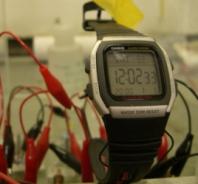| General science | |||
Breakthrough in biological fuel cells3 March 2006 A team of researchers at the University of Oxford has developed an enzyme-based biological fuel cell that uses oxygen and hydrogen to power electrical devices. The enzyme technology is tolerant of gases that poison traditional fuel cell catalysts, removing the need for separation membranes.
The enzymes used are isolated from naturally occurring bacteria that have evolved to use hydrogen in their metabolic process. The unique features of these enzymes are that they are highly selective and tolerant of gases that poison traditional fuel cell catalysts, such as carbon monoxide and hydrogen sulphide. Since the enzymes can be grown they represent a cheap and renewable alternative to the expensive platinum based catalysts used by others in hydrogen fuel cells. The researchers, based in the Chemistry Department headed by Professor Fraser Armstrong, have built a fuel cell consisting of two electrodes, coated with the enzymes, in a small glass tank containing normal air with a few percent of added hydrogen. Since the catalysts are selective and tolerant the gases can be mixed, avoiding the need for an expensive fuel separation membrane which is required for many other types of fuel cell. Professor Armstrong commented on the latest developments as being "a powerful demonstration of the command we have of the hydrogen fuel cell catalyst which will open up applications beyond the current thinking of the fuel cells community and I can envisage their use in smart devices". Professor Armstrong further commented on the technology as having "broad applications as a robust fuel cell for many utility applications where cost is a major issue, clean fuel sources cannot be guaranteed, and instant power is required". Dr Roger Welch of Isis Innovation Limited, the University of Oxford’s Technology Transfer Company said, "We have been working with Professor Armstrong since the initial promising results a few years ago. We are delighted to see the invention powering a useful device, in this case a digital watch, and believe that this marks a milestone in the development process to improve the power density and lifetime of the enzymes. We are very excited about the commercial and environmental benefits of these latest developments since it has the potential to provide the world with a clean and cost effective way of locally generating electricity."
|
